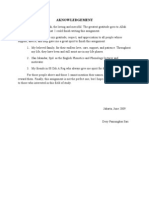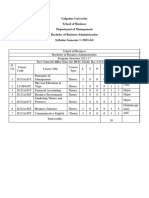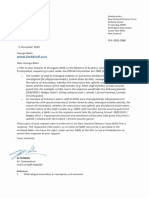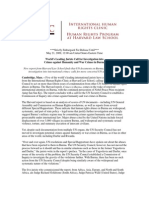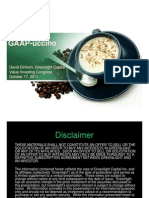L.A. Language Academy: PASSAGE ONE (Question 1-2)
L.A. Language Academy: PASSAGE ONE (Question 1-2)
Uploaded by
HMTS UPS TegalCopyright:
Available Formats
L.A. Language Academy: PASSAGE ONE (Question 1-2)
L.A. Language Academy: PASSAGE ONE (Question 1-2)
Uploaded by
HMTS UPS TegalOriginal Description:
Original Title
Copyright
Available Formats
Share this document
Did you find this document useful?
Is this content inappropriate?
Copyright:
Available Formats
L.A. Language Academy: PASSAGE ONE (Question 1-2)
L.A. Language Academy: PASSAGE ONE (Question 1-2)
Uploaded by
HMTS UPS TegalCopyright:
Available Formats
L.A.
LANGUAGE ACADEMY
DINAS LICENSE: SK 0053/UH/2011/4581/31
Jl. Wonosari km 6 Yogyakarta Phone : 081325311651 instagram : jogjalanguageacademy
EXERCISE 2
PASSAGE ONE (Question 1-2)
Another program instrumental in the popularization of science was cosmos. This series,
broadcast and public television, dealt with topics and issues from varied fields of science. The
principal writer and narrator of the program was Carl Sagan, a noted astronomer and Pulitzer
Prize winning author.
1. The paragraph preceding this passage most probably discussed
(A) A different scientific televisions series
(B) Carl Sagan scientific achievements
(C) The Pulitzer prize won by Carl Sagan
(D) public television
2. The paragraph following this passage likely contains information on what?
(A) The popularity of science
(B) The program cosmos
(C) The astronomer Carl Sagan
(D) Topics and issues from various fields of science
PASSAGE TWO (Question 3-4)
When strong earthquake occurs on the ocean floor rather than on land, a tremendous
force is exerted on the seawater and one on more large, destructive waves called tsunamis can be
formed. Tsunamis are commonly called tidal waves in the United States, but this is really and
inappropriate name in that the cause of the tsunami is an underground earthquake rather than the
oceans tides.
Far from land, a tsunami can move though the wide open vastness of the ocean at a speed of
600 miles (900 kilometers) per hour and often can travel tremendous distance without losing
height and strength. When a tsunami reaches shallow coastal water, I can reach a height of 100
feet (30 meters) or more and can cause tremendous flooding and damage to coastal areas.
3. The paragraph preceding the passage most probably discussed
(A) Tsunamis in various parts of the word
(B) The negative effect of tsunami
(C) Land-based earthquakes
(D) The effect of tides on tsunamis
4. Which of the following is most likely the topic of the paragraph following the passage?
(A) The causes of tsunamis
(B) The destructive effects of tsunamis on the coast
(C) The differences between tsunami and tidal waves
(D) the distance covered by tsunamis
L.A. Language Academy | 1
L.A. LANGUAGE ACADEMY
DINAS LICENSE: SK 0053/UH/2011/4581/31
Jl. Wonosari km 6 Yogyakarta Phone : 081325311651 instagram : jogjalanguageacademy
PASSAGE THREE (Question 5-6)
Off-Broadway theater developed in New York City in about 1950 as a result of
dissatisfaction with conditions on Broadway. Its founders believed that Broadway was overly
concerned with producing safe, commercially successful hit plays rather than drama with artistic
quality. Off-Broadway producers tried to assist playwrights, directors, and performers who could
not find work on Broadway. Off-Broadway theaters were poorly equipped, had limited seating,
and provided few conveniences for audiences. But the originality of the scripts, the creativity of
the performers, and the low cost of tickets made up for these disadvantages, and off-Broadway
theater prospered. However, by the 1960's, costs began to rise and by the 1970's, off-Broadway
theater was encountering many of the difficulties of Broadway and had lost much of its vitality.
With its decline, an experimental movement called off-off-Broadway theater developed.
5. What is the main idea of this passage?
(A) After initial success, off-Broadway theater began to decline.
(B) Off-Broadway theaters produced many hit commercial plays.
(C) Theaters on Broadway were not well equipped.
(D) Off-Broadway plays were highly creative.
6. The paragraph that follows this passage most likely deals with
(A) the help off-Broadway producers provided directors, playwrights, and performers
(B) methods off-Broadway theaters used to cope with rising prices
(C) the development of off-off-Broadway theater
(D) the decline of Broadway theater
PASSAGE FOUR (Question 7-11)
The first Dutch outpost in New Netherlands was made at Fort Orange (now Albany) in
1624; it became a depot of the fur trade. But the most important settlement was at the southern
tip of Manhattan, commanding the great harbor at the mouth of the Hudson River. Peter Minuit,
first governor-general of New Netherlands, "purchased" title to the island from the Canarsie
Indians for the equivalent of twenty four dollars worth of trinkets. However, the Canarsie Indians
might be described as tourists from Brooklyn; Minuit had to make a later payment to the group
that was actually resident there.
In 1626 engineers from Holland arrived in Manhattan to construct Fort Amsterdam.
Within its rectangular walls, permanent houses were built, replacing the thatched dwellings of
the original Manhattanites. The fort became the nucleus of the town of New Amsterdam. Soon
Manhattan had its first skyline: the solid outline of the fort, the flagstaff, the silhouette of a giant
windmill, and the masts of trading ships.
The Dutch West India company established dairy farms in the vicinity of New
Amsterdam. Each morning, the cattle were driven to the "Bouwerie" (now the Bowery), a large
open common in the city. Just southwest of the Bouwerie was the Bowling Green, a level area
where the burghers played ninepins, the ancestor of modern bowling. The Bowling Green
became the site of a cattle fair where livestock were marketed; beer and sausage was available
from booths; cheese, lace, and linen were sold by farmers' wives; and Indian women sold baskets
and other handicrafts. These colorful gatherings and other aspects of everyday life in New
L.A. Language Academy | 2
L.A. LANGUAGE ACADEMY
DINAS LICENSE: SK 0053/UH/2011/4581/31
Jl. Wonosari km 6 Yogyakarta Phone : 081325311651 instagram : jogjalanguageacademy
Amsterdam are described in Washington Irving's rollicking book, Diedrich Knickerbocker's
History o/New York.
The last and most powerful governor-general of New Netherlands was Peter Stuyvesant.
famous for his temper and his wooden leg. He annexed the Swedish colony of Delaware and
ordered the streets of few Amsterdam laid out in an orderly manner and numbered. He did his
best to obtain military and financial aid from Holland against the British. When the British sent
emissaries demanding the surrender of the colony, he wanted to fight.
Four British warships, commanded by Colonel Richard Nicolls, sailed into the harbor in
1664. The fort was long out of repair, and there was a shortage of ammunition. Stuyvesant had
no choice hut to surrender. New Netherlands became the British colony of New York. and New
Amsterdam became New York City.
7. What is the main topic of the first paragraph?
(A) Tourism in Manhattan
(B) Peter Minuit's acquisition of Manhattan
(C) The first Dutch settlement in New Netherlands
(D) A governor of New Netherlands
8. The second paragraph deals primarily with
(A) The establishment of Fort Amsterdam
(B) The skyline of Manhattan
(C) The thatched houses of the Indians
(D) The nucleus of the town of New Amsterdam
9. The third paragraph mainly describes
(A) Selling of baskets and handicrafts by Indian women
(B) The origin of the game of modern bowling
(C) Washington Irving's book about New Amsterdam
(D) Aspects of everyday life in New Amsterdam
10) What does the fourth paragraph mainly discuss
(A) The annexation of the Swedish colony of Delaware
(B) The ordering of the streets in New Amsterdam
(C) A description of Peter Stuyvesant and his accomplishments
(D) Fighting of Holland against British
11). What is the primary topic of the entire passage?
(A) A history of the British colony of New York
(B) The origin and importance of the Cattle Fair
(C) European colonization in the New World
(D) Forty years of Dutch rule in New Amsterdam
L.A. Language Academy | 3
You might also like
- Sewage Plant ManualDocument79 pagesSewage Plant Manualankurkatiyar100% (7)
- Daily Life in The Age of Sail (History Ebook) PDFDocument343 pagesDaily Life in The Age of Sail (History Ebook) PDFWalter Macedo100% (4)
- A Companion To Australian ArtDocument546 pagesA Companion To Australian ArtYaryna GulaNo ratings yet
- Reading Practice Test: English Practicum - STIESIA SurabayaDocument10 pagesReading Practice Test: English Practicum - STIESIA SurabayaZalfachitaNo ratings yet
- Contoh Kalimat 16 TensesDocument2 pagesContoh Kalimat 16 TensesNto WaoneNo ratings yet
- TOEFL BookDocument65 pagesTOEFL BookYogi Seta AnggaraNo ratings yet
- History of Canadian Theatre - RevisedDocument2 pagesHistory of Canadian Theatre - Revisedapi-202765737No ratings yet
- Lithium Battery Solution For Telkomsel - V0.0.0 PDFDocument9 pagesLithium Battery Solution For Telkomsel - V0.0.0 PDFDaman HuriNo ratings yet
- UNIT 3. Cross-Cultural Conflict and Adjustment: Newcomer (After One Month in The United States)Document13 pagesUNIT 3. Cross-Cultural Conflict and Adjustment: Newcomer (After One Month in The United States)Bagus AndrianNo ratings yet
- Listening 1 RPP TEYLDocument3 pagesListening 1 RPP TEYLtatiNo ratings yet
- Sharizan - 180511073 - Final Test Penelitian PendidikanDocument15 pagesSharizan - 180511073 - Final Test Penelitian PendidikanPutri Indah Sari 1805111317100% (1)
- Section 3c. Reading ComprehensionDocument21 pagesSection 3c. Reading Comprehensionnamira ghina safitriNo ratings yet
- Hubungan Antara Fungsi Keluarga Dan Kualitas Hidup LansiaDocument7 pagesHubungan Antara Fungsi Keluarga Dan Kualitas Hidup LansiarickyNo ratings yet
- PERTEMUAN 11 B.INGGRIS (Fera Nurjanah, 5B Keperawatan)Document9 pagesPERTEMUAN 11 B.INGGRIS (Fera Nurjanah, 5B Keperawatan)Fera NurjanahNo ratings yet
- TOEFLDocument2 pagesTOEFLElvira Eka RamadhaniNo ratings yet
- Toefl Exercise 02Document2 pagesToefl Exercise 02Maulidya SilvianaNo ratings yet
- Makalah EppDocument12 pagesMakalah Eppdesys_4100% (1)
- Contoh Program Dan Laporan Bimbingan Dan KonselinDocument85 pagesContoh Program Dan Laporan Bimbingan Dan KonselinUlfa 'itemputi'No ratings yet
- Elizabeth BlackwellDocument4 pagesElizabeth BlackwellYusni SinagaNo ratings yet
- TOEFL Reading SectionDocument39 pagesTOEFL Reading SectionliansiraitNo ratings yet
- SOAL UTS Poetry Genap 2020Document5 pagesSOAL UTS Poetry Genap 2020Zara AzkiyahNo ratings yet
- Don's TOEFL Reading Comprehension-27Document1 pageDon's TOEFL Reading Comprehension-27MusesuNo ratings yet
- Reading Part 3 PETDocument78 pagesReading Part 3 PETChi HoàngNo ratings yet
- Fun Free Quiz About BritainDocument6 pagesFun Free Quiz About BritainWoo TungNo ratings yet
- Antipodean Currents Ten Contemporary Artists From AustraliaDocument162 pagesAntipodean Currents Ten Contemporary Artists From Australiarollthebones11100% (1)
- New York City History for Kids: From New Amsterdam to the Big Apple with 21 ActivitiesFrom EverandNew York City History for Kids: From New Amsterdam to the Big Apple with 21 ActivitiesRating: 3.5 out of 5 stars3.5/5 (4)
- HistoryDocument9 pagesHistoryKhiri's TeamNo ratings yet
- Class B NOtesDocument3 pagesClass B NOtesupupdadaNo ratings yet
- DowntownDocument3 pagesDowntownRobert BonisoloNo ratings yet
- Nugroho Syahputra - TOEFL Reading ExerciseDocument5 pagesNugroho Syahputra - TOEFL Reading ExerciseNET BINARYNo ratings yet
- Reading Passages 3Document21 pagesReading Passages 3adaletya50% (2)
- Bad Business Aimbot - LinkvertiseDocument6 pagesBad Business Aimbot - Linkvertiseblurr feddieNo ratings yet
- Full Test 16 PDFDocument4 pagesFull Test 16 PDFhoang lichNo ratings yet
- Reading 1Document7 pagesReading 1nadaNo ratings yet
- Ny DNL PDFDocument5 pagesNy DNL PDFamokraneTNo ratings yet
- skivie_DiagramDocument2 pagesskivie_Diagramcristhian navarroNo ratings yet
- Embassy to the Eastern Courts: America's Secret First Pivot Toward Asia, 1832–37From EverandEmbassy to the Eastern Courts: America's Secret First Pivot Toward Asia, 1832–37No ratings yet
- Shipbuilding on Prince Edward Island: Entreprise in a Maritime setting, 1787-1920From EverandShipbuilding on Prince Edward Island: Entreprise in a Maritime setting, 1787-1920No ratings yet
- Reading - Overview and Topics, Main IdeasDocument2 pagesReading - Overview and Topics, Main IdeasHải Anh VũNo ratings yet
- PDF British Culture of the Post War An Introduction to Literature and Society 1945 1999 1st Edition Alastair Davies downloadDocument84 pagesPDF British Culture of the Post War An Introduction to Literature and Society 1945 1999 1st Edition Alastair Davies downloadguluerraji100% (10)
- Best ThingDocument7 pagesBest ThingTabish SamarNo ratings yet
- Discovery at Rosetta: Revealing Ancient EgyptFrom EverandDiscovery at Rosetta: Revealing Ancient EgyptRating: 4 out of 5 stars4/5 (1)
- The History of Canada Series: War in the St. Lawrence: The Forgotten U-boat Battles On Canada's ShoresFrom EverandThe History of Canada Series: War in the St. Lawrence: The Forgotten U-boat Battles On Canada's ShoresNo ratings yet
- Hist8671 7543Document4 pagesHist8671 7543muhammad zulfikarNo ratings yet
- Хистория Британии писательнаяDocument5 pagesХистория Британии писательнаяludwigostolfNo ratings yet
- A Cultural History of The British EmpireDocument451 pagesA Cultural History of The British EmpireMahira Farhan67% (3)
- CeltsDocument156 pagesCeltsEngin Beksac100% (6)
- Sightseeing QuizDocument33 pagesSightseeing QuizСветлана МясоедоваNo ratings yet
- The Pritzker Prize - Jorn UtzonDocument50 pagesThe Pritzker Prize - Jorn UtzonJ100% (1)
- 2Document4 pages2marthaNo ratings yet
- Reading MaterialsDocument32 pagesReading Materialsmaryailene.aldayNo ratings yet
- BBA (2023-24) Semester 1 SyllabusDocument17 pagesBBA (2023-24) Semester 1 Syllabusnavneetkryadav17No ratings yet
- List of Recipients of Jnanpith Awards 1965 To 2019Document4 pagesList of Recipients of Jnanpith Awards 1965 To 2019Soham DebsarkarNo ratings yet
- Garcia vs. CADocument13 pagesGarcia vs. CAAP CruzNo ratings yet
- National Innovation and Startup Policy (Nisp) For Students and Faculty in HeisDocument18 pagesNational Innovation and Startup Policy (Nisp) For Students and Faculty in HeisamitcmsNo ratings yet
- Https:/bhu2.Ucanapply - com/Result2022PG/entrance/final Result Practical.pDocument2 pagesHttps:/bhu2.Ucanapply - com/Result2022PG/entrance/final Result Practical.pMahesh DHF (Babu)No ratings yet
- Fundamental Concepts of Facility ManagementDocument11 pagesFundamental Concepts of Facility ManagementJescelyn SyChangcoNo ratings yet
- GeM Bidding 3464959Document7 pagesGeM Bidding 3464959Hetal PatelNo ratings yet
- Affidavit of Clarification of Citizenship For Security ClearanceDocument3 pagesAffidavit of Clarification of Citizenship For Security Clearancedouglas jonesNo ratings yet
- EMERGENCIES IN EDUCATION FORM 3 EPP 5 Oct 3 4,2024Document3 pagesEMERGENCIES IN EDUCATION FORM 3 EPP 5 Oct 3 4,2024marvin.valencia001No ratings yet
- Problems That Arise in The Installation of Primavera P6Document8 pagesProblems That Arise in The Installation of Primavera P6Fito D.WNo ratings yet
- Jadwal Perkuliahan Kelas Solafide Semester Gasal 2022-2023Document6 pagesJadwal Perkuliahan Kelas Solafide Semester Gasal 2022-2023JUN ALBERT CARLES ZNo ratings yet
- Hanbali Sufi HistoryDocument10 pagesHanbali Sufi HistoryDawudIsrael1100% (1)
- A Review On Ethanol Steam Reforming For Hydrogen Pro - 2022 - International JourDocument37 pagesA Review On Ethanol Steam Reforming For Hydrogen Pro - 2022 - International JourSaepulloh Rahmat SolehudinNo ratings yet
- NZDF Misconduct OIADocument2 pagesNZDF Misconduct OIAStuff NewsroomNo ratings yet
- Đề minh hoạ số 1.4Document2 pagesĐề minh hoạ số 1.4Thanh HoaNo ratings yet
- Animal Lives and Why They Matter (Arne Johan Vetlesen)Document272 pagesAnimal Lives and Why They Matter (Arne Johan Vetlesen)khun sakNo ratings yet
- Documentary Analysis OutlineDocument3 pagesDocumentary Analysis OutlineNicole MangibinNo ratings yet
- Shahada and Al Firdous Are Beneath The Shade of SwordsDocument84 pagesShahada and Al Firdous Are Beneath The Shade of SwordsAl Andalus0% (1)
- FRM Exam QuestionsDocument4 pagesFRM Exam QuestionsNayden GeorgievNo ratings yet
- Press Release EmbargoedDocument2 pagesPress Release EmbargoedbdcburmaNo ratings yet
- Syllabus Legal English ClassDocument5 pagesSyllabus Legal English Classauden28388No ratings yet
- Mastery SummaryDocument9 pagesMastery Summarylaikienfui0% (3)
- ch10 PPTDocument32 pagesch10 PPTFrenklinNo ratings yet
- 10 Lesson 8 Attach Pronouns P 11 PDFDocument15 pages10 Lesson 8 Attach Pronouns P 11 PDFmanouche123No ratings yet
- Essentially Good: Fully Alive"Document12 pagesEssentially Good: Fully Alive"Jhunnel SarajanNo ratings yet
- HR Analytics CA1 Individual Report - Hong Zi XuanDocument6 pagesHR Analytics CA1 Individual Report - Hong Zi XuanamrithaNo ratings yet
- David Einhorn's Presentation On Green Mountain RoastersDocument110 pagesDavid Einhorn's Presentation On Green Mountain RoastersDealBook100% (1)
- ESL - Cultural English - BARACK OBAMADocument3 pagesESL - Cultural English - BARACK OBAMAelizabeth vieiraNo ratings yet
















